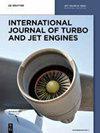涡轮螺旋桨发动机废气撞击对推进飞机影响的实验与数值研究
IF 0.9
4区 工程技术
Q4 ENGINEERING, AEROSPACE
引用次数: 1
摘要
摘要涡轮螺旋桨发动机需要一个排气喷嘴或排气管,将发动机的废气输送到飞机外侧。这些排气管的设计主要由飞机的配置决定。在推进式飞机中,排气管设计用于最大限度地减少发动机排气中的烟气暴露在螺旋桨叶片和机身上。进行了流体-热-结构耦合分析,以了解发动机排气射流对推进器配置的轻型运输机螺旋桨和结构的热机械性能的热影响。分析了具有正向和反向推力的飞机的稳态热流场,其中螺旋桨叶片角度在不同飞机速度下的变化。本工作研究了机舱机身周围流动的三维分析以及排气冲击对螺旋桨叶片表面的影响。基于数值结果的见解,将设计的排气管集成在飞机上,并在各种飞行工况下进行了地面静态和飞行测试,其中测量了螺旋桨叶片和机身表面温度。对某些飞行条件下的数值结果和实验结果进行了比较和验证,结果令人满意。本文章由计算机程序翻译,如有差异,请以英文原文为准。
Experimental and numerical investigation on the effect of turboprop engine exhaust gas impingement on pusher aircraft
Abstract Turboprop engines require an exhaust nozzle or stub to duct the engine exhaust flue gas outboard of the aircraft. The design of these exhaust stubs are dictated primarily by the aircraft’s configuration. In pusher aircraft, the exhaust stubs are designed to minimize the exposure of the flue gases from the engine exhaust on the propeller blades and fuselage. A fluid-thermal-structure coupling analysis is performed to understand the thermal effects of the engine exhaust jet flow on the thermo-mechanical behavior of pusher configured light transport aircraft propeller and structure. The steady thermal flow field of the aircraft with forward and reverse thrust, in which propeller blade angle variations were analyzed for different aircraft speed. The present work investigates a three-dimensional analysis of flow around the nacelle-airframe and the effect of exhaust flue gas impingement on the propeller blade surface. Based on the insights from the numerical results, the designed exhaust duct was integrated on the aircraft and carried out ground static and flight testing for various flight operating conditions in which propeller blade and fuselage surface temperature were measured. Numerical and experimental results are compared and validated for certain flight conditions and found satisfactory.
求助全文
通过发布文献求助,成功后即可免费获取论文全文。
去求助
来源期刊

International Journal of Turbo & Jet-Engines
工程技术-工程:宇航
CiteScore
1.90
自引率
11.10%
发文量
36
审稿时长
6 months
期刊介绍:
The Main aim and scope of this Journal is to help improve each separate components R&D and superimpose separated results to get integrated systems by striving to reach the overall advanced design and benefits by integrating: (a) Physics, Aero, and Stealth Thermodynamics in simulations by flying unmanned or manned prototypes supported by integrated Computer Simulations based on: (b) Component R&D of: (i) Turbo and Jet-Engines, (ii) Airframe, (iii) Helmet-Aiming-Systems and Ammunition based on: (c) Anticipated New Programs Missions based on (d) IMPROVED RELIABILITY, DURABILITY, ECONOMICS, TACTICS, STRATEGIES and EDUCATION in both the civil and military domains of Turbo and Jet Engines.
The International Journal of Turbo & Jet Engines is devoted to cutting edge research in theory and design of propagation of jet aircraft. It serves as an international publication organ for new ideas, insights and results from industry and academic research on thermodynamics, combustion, behavior of related materials at high temperatures, turbine and engine design, thrust vectoring and flight control as well as energy and environmental issues.
 求助内容:
求助内容: 应助结果提醒方式:
应助结果提醒方式:


